Few games out there hold the same influence as Fortnite does. This isn’t a game that is only popular with some remote segment of the gaming industry. Quite the contrary, this title has actually made a cultural impact.
From creating new celebrities to starting a victory dance culture, Fortnite has cemented its way to becoming one of the most well-known gaming titles in the industry.
The game is essentially a third-person game set in the classic Battle Royale genre, where you have to gather resources and fight to survive until you are the last player standing.
As far as its eSports nature goes, this title is one of the LARGEST eSports games at the moment, placing itself in the top 5 in terms of overall prize money awarded.
In fact, a whole section of the game is dedicated to professional competitive gameplay. Everyone can earn their way into the flagship cash prize tournaments, which is a great incentive for many to hone their skills at this game.
It is perhaps for this reason that many gamers invest in a good gaming rig for Fortnite. Of course, a good gaming PC that meets the Fortnite hardware requirements with ease can give you a competitive edge over your opponents.
Fortunately, Fortnite is a light game. Hence, the recommended PC for this game does not have to be an expensive machine. The minimum and even the recommended requirements of the game are designed so that most players can enjoy the game easily at respectable frame rates.

TABLE OF CONTENTS
What is Fortnite, and Why is it So Popular?
When the game was originally released in 2017, it was essentially a third-person co-op shooter. The original game mode, “Save the World,” aimed to gather resources, build forts and fend off hordes of zombies either by yourself or with a team of 4 players.
The original game cost as much as any AAA title would.
However, later in the same year, the game released a new standalone free-to-play mode called the Battle Royale mode. This is what really catapulted the success of the game.
The Battle Royale mode was partly inspired by PlayerUnknown’s Battlegrounds, released earlier in 2017. But originally, this game mode takes its ultimate inspiration from a Japanese Action-Thriller film with the same name, i.e., Battle Royale, released in 2000, in which a group of students is forced to fight to the death.
What is Fortnite Battle Royale Mode?

Fortnite Battle Royale is currently the game’s flagship mode, where up to 100 players fight off against each other to death.
You can play this game solo or in groups of up to 4 players.
As the game starts, you are first parachuted onto a huge island. You then collect resources, weapons, and armor to build fortifications and kill off your opponents.
At the same time, as the game progresses, the EYE OF THE STORM also starts to shrink. The eye of the storm is basically a large circle that gradually gets smaller and smaller.
Anyone inside the Eye of the Storm is in the safe zone, whereas anyone outside takes damage and ultimately dies. This circle aims to force players into an encounter, basically. So essentially, it works as a timer for the game and also as an excellent anti-camping mechanism.
The last player or the team standing wins the game.
Spare a Sec for a Brief Poll
The following survey will help me improve the article and will only take you about half a sec to complete. : )…
Why Is Fortnite So Popular?
There are plenty of reasons for this game’s popularity; I am listing a few here:
- The game is free-to-play, so it has no barriers to entry as far as finances are concerned. Therefore, gamers of all age groups and demographics can enjoy the game.
- Requires weak PC hardware. This further removes the barriers to entry.
- Cartoon-like graphics and a very light-hearted art style make this a favorite among professional and casual gamers.
- It has a huge competitive scene, with the game being ranked in the top 5 in terms of the overall prize eSports prize pool.
- Constant content updates keep the game fresh.
Fortnite – One of the Most Popular eSports Games
As mentioned earlier, Fortnite is huge in eSports. There is a whole section of the game dedicated to its competitive aspect.
There are two aspects to the competitive aspect of this game
- Arena – The normal mode where you earn HYPE POINTS
- Fortnite Champion Series – The flagship Fortnite eSports series with a prize pool.
What is Fortnite Arena?
So basically, this is the default game mode where you play and earn hype points.

As you earn Hype Points, you climb the Hype Leaderboard and progress further into various leagues.
Once you have gathered enough Hype Points and reached the Champion League, you can look into your chances for the flagship Fortnite Champion Series.
What is Fortnite Champion Series?
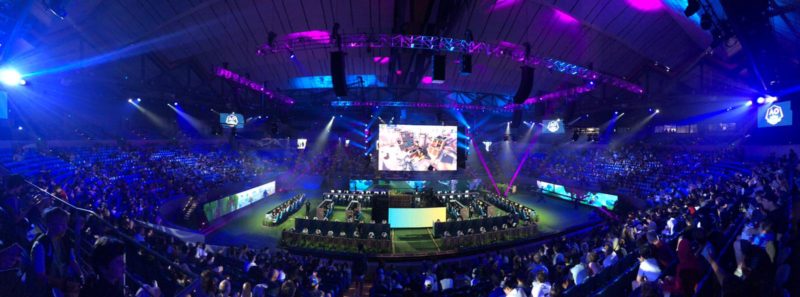
Fortnite Champion Series is the ultimate tournament series where Champion ranked players, and Champion ranked teams compete against each other.
This tournament series has the biggest rewards and the biggest cash pool prize.
Qualifying for the Championship seasons is arduous, and only the biggest teams and Fortnite stars qualify for the finals.
Build Guide for Fortnite
Overall, Fortnite is a relatively light game and does not require extraordinary PC hardware to run it. Therefore, your PC Build for Fortnite DOES NOT have to be expensive.
Like most online eSports games out there, the game has intentionally been designed to be light on demand so that it can appeal to most gamers.
This is in part thanks to the extensive graphics settings, which cater to both those who play on budget PCs and those who play on high-end gaming rigs.
As such, there is a huge difference between the minimum and the recommended requirements for the game. The minimum requirements would appeal to budget gamers, whereas the recommended requirements appeal to those who have a high-end system.
But as far as running the game and enjoying it on respectable frame rates, a low to low-mid-range gaming PC can suffice.
In the following text, I will review the official system requirements for Fortnite PC Build and then break down the recommendations/benchmarks for each component.
Official Fortnite System Requirements
The following are the official system requirements for Fortnite.
Minimum Requirements
| CPU | Intel Core i3-3225 (3.3 GHz) |
| GPU | Intel HD 4000 on PC Intel Iris Pro 5200 on Mac |
| RAM | 4 GB DDR4 RAM |
| Hard Drive | 30 GB (May change over time as the game updates and gets bigger) |
| Operating System | Windows 7 (64 Bit) or Newer Mac OS Mojave 10.14.6 |
Recommended Requirements
| CPU | Intel Core i5-7300U (3.5 GHz) |
| GPU | NVIDIA GTX 960 AMD R9 280 |
| RAM | 8 GB |
| Hard Drive | 30 GB (May change over time as the game updates and gets bigger) |
| Operating System | Windows 7 (64 Bit) or Newer Mac OS Mojave 10.14.6 |
New Epic Quality Recommendations
Epic recently improved the graphics for Fortnite (Starting Chapter 2, Season 7, and onwards). Due to the graphic overhaul, the game now demands better hardware specifications for running it on EPIC graphics settings.
Essentially with this new upgrade, the current High Settings are equivalent to the EPIC Settings of the past version.
| CPU | Intel Core i7-8700 AMD Ryzen 7 3700x |
| GPU | Nvidia GTX 1080 |
| RAM | 16 GB |
| Hard Drive | 30 GB (May change over time as the game updates and gets bigger) |
| Operating System | Windows 10 (64 Bit) or Newer |
It can be seen from the official system requirements that there is a huge spectrum of PC hardware that this game can support. It is almost a miracle that the game is designed to cater to lower-end gamers (gamers with nothing more than an iGPU) to gamers running it on high-end systems.
Of course, the game’s visuals will vastly differ when comparing Low and EPIC settings, but as far as the competitive gameplay goes, it would not have much of an effect.
A gamer playing the game on a potato PC may outperform a gamer playing on a high-end gaming rig that costs thousands of dollars.
As it stands, this is how the Fortnite System requirements are designed:
- Minimum Requirements: Will meet Low Graphics Preset
- Recommended Requirements: Will meet High Graphics Preset
- Epic Requirements: Will meet Epic Graphics Preset
With that said, let us talk in-depth about the hardware components the game requires.
I. CPU Requirements for Fortnite
The official requirements allude to three different categories of processors:
- Low End: Intel Core i3-3225 (3.3 GHz)
- High End: Intel Core i5-7300U
- Epic: AMD Ryzen 7 3700x
Low-End Category CPUs for Fortnite
In the first category, we can see that you can aim for a weak system if you have a low budget. As you will see in the benchmarks below, even the entry-level CPUs of today can easily surpass the dual-core Intel Core i3-3225 released in 2012.
Therefore, if you are building a gaming desktop PC for Fortnite TODAY, meeting the minimum requirements would not be an issue.
High-End Category CPUs for Fortnite
The second category defines the CPU recommended for playing the game with high graphics.
Note that the CPU mentioned here is a mobile processor released in 2017. The Intel Core i5-7300U is also a dual-core CPU. Again, for the current-gen desktop CPUs, beating the performance of mobile-grade CPUs released in 2017 would not be an issue.
The point is that you do not need a top-of-the-line CPU to enjoy the game at high graphics.
Epic Category CPU for Fortnite
The Intel Core i7-8700 and the AMD Ryzen 7 3700X are much beefier processors than the ones recommended for the high-end build above. CPUs in this category are reserved for the top-of-the-line PCs for Fortnite and are intended for pros.
In all honesty, unless you stream Fortnite gameplay, you do not need a CPU that features eight cores and 16 threads. Intel Core i7-8700 and the AMD Ryzen 7 3700X are overkill for playing Fortnite alone.
The disparity between the high-end recommendations and the Epic recommendations is too great. While the high-end category recommends having a dual-core CPU, the Epic settings recommend having a whopping octa processor. That is a huge jump in specs, IMO.
The game doesn’t even use that many CPU cores.
So again, why go for the Intel Core i7-8700 or the AMD Ryzen 7 3700X? Essentially, the CPUs recommended here are, in my opinion, for Fortnite streamers.
Streaming can devour your core count. If you have any kind of screen recording app running in the background while playing a game like Fortnite, you need to supply your PC with many cores.
The more cores you have, the smoother your streams will be at higher resolution, as more cores equal faster rendering.
So What Current Gen CPUs Do I Recommend for Fortnite?
The game generally recommends having a dual-core and a four-thread processor judging from its Minimum and Recommended requirements.
To gauge how the current-gen CPUs stack up against the recommended CPU, the following table and benchmarks should help.
Note that the Passmark benchmarks show the overall score of the processor. When looking for a streaming build, you would instead look at the multi-core performance of the CPU. For that, I recommend the Cinebench R15 benchmark scores. (Scores shown below)
| CPU | Specs | PassMark Benchmark | Remarks |
| Intel Core i3-3225 (MSRP $134) Released: 2012) | 2 Cores 4 Threads 3.06 GHz | 2193 | Official MINIMUM Requirements |
| Intel Celeron G5900 (MSRP $42) | 2 Cores 2 Threads 3.5 GHz | 2768 | For Low-End Build |
| Intel Core i5-7300U (Released: 2017) | 2 Cores 4 Threads 3.5 GHz | 3748 | Official RECOMMENDED Requirements |
| Intel Pentium Gold G6400 (MSRP $64) | 2 Cores 4 Threads 4.00 GHz | 4173 | Entry-Level: Meets Recommended Requirements |
| AMD Athlon 3000G (MSRP $50) | 2 Cores 4 Threads 3.5 GHz | 4455 | Entry-Level: Meets Recommended Requirements |
| AMD Ryzen 3 3200G (MSRP $99) | 4 Cores 4 Threads 4.0 GHz | 7226 | For Mid-Range Build |
| Intel Core i3 10100 (MSRP $122) | 4 Cores 8 Threads 4.3 GHz | 8823 | For Mid-Range Build |
| AMD Ryzen 5 3400G (MSRP $$150) | 4 Cores 8 Threads 4.2 GHz | 9372 | For Mid-Range Build |
| AMD Ryzen 3 3100 (MSRP $$99) | 4 Cores 8 Threads 4.0 GHz | 11723 | For Mid-Range Build |
| AMD Ryzen 3 3300X (MSRP $120) | 4 Cores 8 Threads 4.3 GHz | 12739 | For Mid-Range Build |
| Intel Core i7-8700 (MSRP $303 Released: 2017) | 6 Cores 12 Threads 4.6 GHz | 13082 | Official Recommended for EPIC Settings |
| Intel Core i5-10600K (MSRP $272) | 6 Cores 12 Threads 4.8 GHz | 14549 | For Epic Settings / Fortnite Streaming |
| AMD Ryzen 5 3600X (MSRP $250) | 6 Cores 12 Threads 4.4 GHz | 18316 | For Epic Settings / Fortnite Streaming |
| Intel Core i7-10700K (MSRP $384) | 8 Cores 16 Threads 5.1 GHz | 19474 | Fortnite Streaming at High FPS or High Resolution |
| AMD Ryzen 5 5600X (MSRP $299) | 6 Cores 12 Threads 4.6 GHz | 22163 | For Epic Settings / Fortnite Streaming |
| AMD Ryzen 7 3700X (MSRP $329) | 8 Cores 16 Threads 4.3 GHz | 22788 | Official Recommended for EPIC Settings |
| Intel Core i7-11700K (MSRP $409) | 8 Cores 16 Threads 4.5 GHz | 25025 | Fortnite Streaming at High FPS and High Resolution |
| AMD Ryzen 7 5800X ($449) | 8 Cores 16 Threads 4.7 GHz | 28522 | Fortnite Streaming at High FPS and High Resolution |
- The CPU, according to the official requirements, is colored blue
- Passmark scores are taken from cpubenchmark.net
What you can deduce from here is that there are two types of CPU recommendations:
- Non-Streaming Build CPUs (4 Cores or less)
- Streaming Build CPUs (More than 4 Cores)
Cinebench R15 Single Core Performance Scores
If you are a non-streamer, you would ideally want a CPU with the best single-core performance in your budget category.

- Scores are taken from CPU-monkey.
Cinebench R15 Multi-Core Performance Scores
If you are a Fortnite streamer, you would prefer a CPU with the best multi-core performance in your budget category.
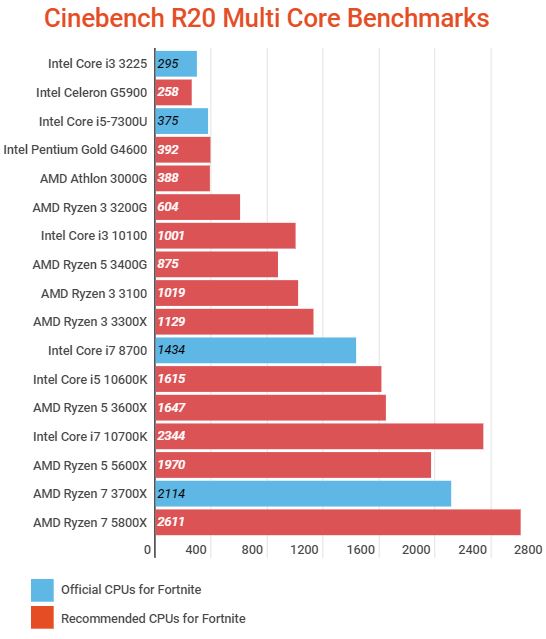
- Scores are taken from CPU-monkey.
You must balance and gauge for yourself whether you value a better single-core or multi-core performance.
A prime example is the comparison between the Intel Core i7-10700K and the AMD Ryzen 5 5600X. The former has an excellent multi-core performance, while the latter has an excellent single-core performance.
If, for instance, you are considering either of these two, then for a streaming PC for Fortnite, Intel Core i7-10700K would be the ideal choice. For a non-streaming Fortnite PC build, the AMD Ryzen 5 5600X would be the wiser choice.
How Many Cores Does Fortnite Actually Use?
Fortnite requires two cores judging by the CPUs mentioned in the minimum and recommended requirements of the game.
The Intel Core i3 3225 and the Intel Core i5 7300U are dual-core processors with hyper-threading enabled. So two cores / 4 threads.
A test done by Tomshardware also confirms this:
Two of our Ryzen processor’s cores are more heavily utilized than the rest – Tomshardware
This is consistent with my test as well:
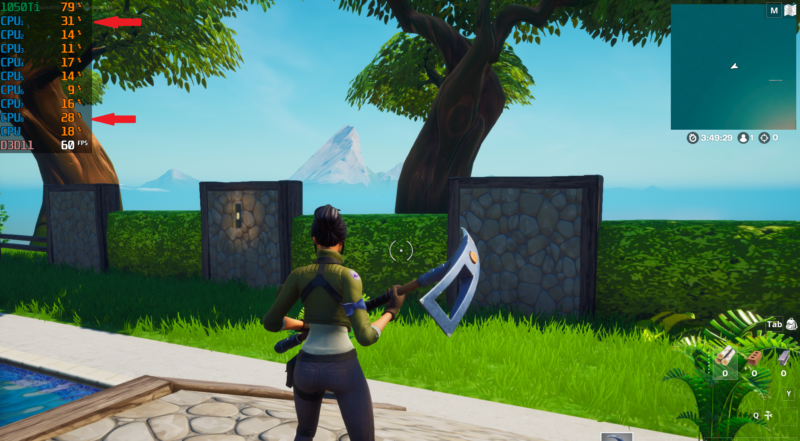
I tested the game on an Intel Core i7-7700HQ 4 Core / 8 Threads processor. At no point did any of the cores saturate, indicating that four cores and eight threads were overkill.
At the same time, only two cores were utilized more than the rest. This is consistent with the claim made by Tomshardware and indicates that this game is predominantly dual-core.
However, I would recommend that you go for at least a quad-core CPU because most systems today have a lot of background services and applications running. The more background apps you run, the more you will benefit from a higher core count.
Summary
Any CPU beyond four core count is practically a CPU for Fortnite streaming build.
Any current-gen CPU from the entry-level and budget segment would be sufficient for a casual and professional gamer who DOES NOT stream.
To save you from the hassle of system lags or a bad experience, I do not recommend going for the entry-level AMD Athlon or the Intel Celeron CPUs. However, even these would suffice if you are on a tight budget.
The sweet spot, in my opinion, is the 10th gen Intel Core i3 and 3000 series AMD Ryzen CPUs. These quad-core CPUs have enough juice for a highly capable Fortnite Gaming PC build. They beat the Intel Core i5-7300U (as stipulated in the recommended requirements) by a long shot.
Fortnite Streaming CPUs
If you are a Fortnite streamer, that is a completely different ball game. x264 software encoding on platforms like Twitch or YouTube can utilize A LOT of your CPU power.
Encoding can be taxing on your system. x264 will utilize a lot of your CPU, resulting in lower FPS. – Twitch.tv
The higher the FPS or, the higher the resolution of your game, the beefier the CPU you will need for encoding the data for streaming.
Basically, for casual 1080P streaming at 60FPS, a 6-core current-gen CPU would suffice. However, for streaming beyond 60FPS or at higher resolution, i.e., QHD or 4k, an 8-core CPU may be warranted.
Its multi-core performance is a very important parameter to gauge how well a CPU will perform for streaming.
More Cores for Demanding Stream Settings
The more demanding the encoding settings are, the more cores you need. Essentially, the higher the quality of the streams you want, the more cores you need.
According to Twitch,
Presets above Faster require CPUs with 6+ cores. – Twitch.tv
Faster preset on Twitch requires fewer cores; the slower the preset, the more cores you need.
This is because, on slower preset, the CPU cores will work harder and at a slower pace to ensure a high image quality.
Therefore, your FPS can take a hit on a slower preset if you do not have a high enough core count. The higher the core count, the more resources the CPU has for the game and for encoding to simultaneously take place at high quality.
II. Graphics Card for Fortnite
Just like with CPUs, there are three levels of recommendations for Graphics Card for Fortnite as well:
- Entry: Intel HD 4000 or Intel Iris Pro 5200 – For Bear Minimum
- High: Nvidia GTX 960 or AMD Radeon R9 280 – For High Preset
- Epic: Nvidia GTX 1080 – For Epic Preset
To understand the power of these GPUs, it would be best to benchmark these along with a list of other recommended Graphics cards for Fortnite. (Benchmark Provided Below)
Can You Play Fortnite on an Integrated GPU like an Intel HD Graphics Card?
While the game’s minimum requirements do point to the fact that it can work on an Intel HD 4000 integrated CPU released all the way back in 2012, I have to check this by myself.
Therefore, I have tested the game on my integrated GPU, the Intel UHD 630, running on a system with Intel Core i7-7700HQ and 16 GB of RAM.
Testing on Intel UHD 630 Low Settings and 3D Resolution to 100% (FHD)
So first, I tested the game by setting it to FHD resolution, low settings, and keeping the 3D Resolution to a max of 100%.
Here is a screenshot of the frame rates:
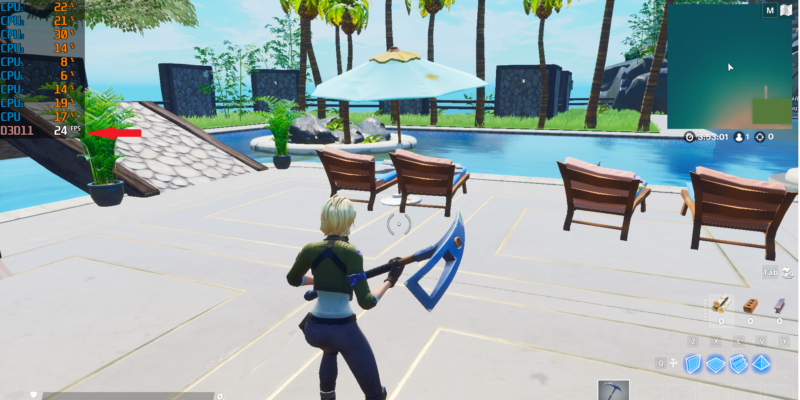
At 100% 3D Resolution setting, the game was barely playable. It constantly hovered at 23-25 FPS in idle creative mode. You can expect more frame drops if you play it in an action-packed game.
Testing on Intel UHD 630 Low Settings and 3D Resolution to 50% (FHD)
After dialing down the 3D resolution to about 50%, I started to get awesome results with my frame rates:
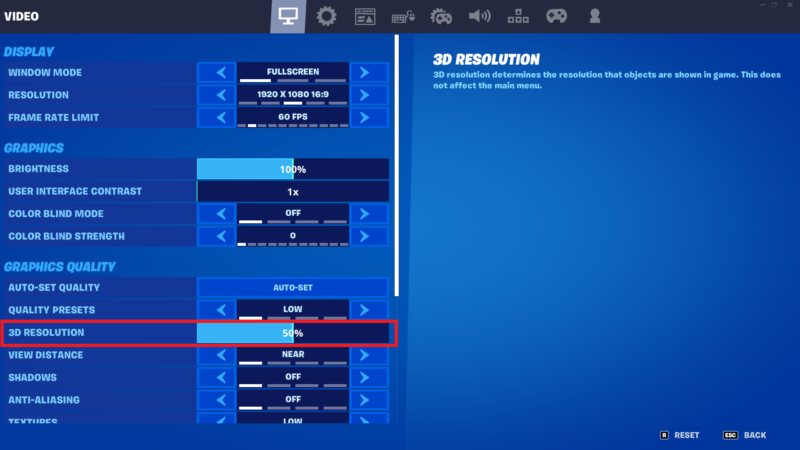
I was getting about 60 FPS constantly, even on an Intel UHD 630 – one of the weakest graphics cards there is:
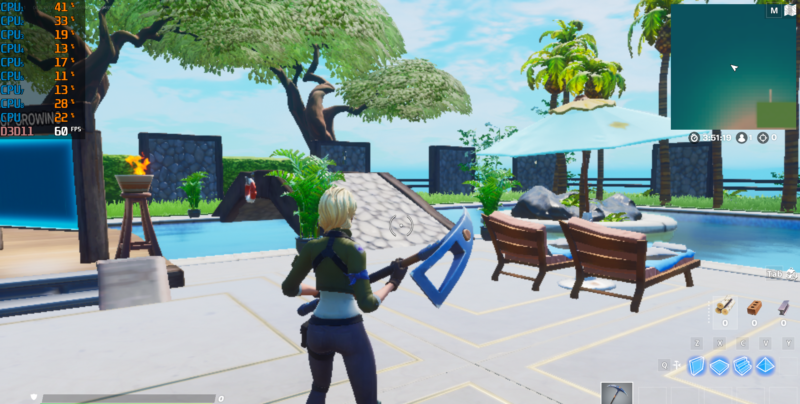
While the game maintained a very smooth 60 FPS, it looked horrendous. The graphics were too pixelated for my taste.
But the point to note here is that the game DOES work on an integrated graphics card.
How does the Game Play on a Mid-Range NVIDIA GTX 1050Ti
I will test the game on my mid-range NVIDIA GTX 1050Ti (Mobile) graphics card.
Regarding benchmark scores the NVIDIA GTX 1050Ti sits almost between the least recommended Intel HD 4000 and the recommended GTX 1080 Fortnite graphics cards.
As such, you can assume that this GPU would suit medium to medium-high graphics.
But here are the results. The game was tested at 100% 3D resolution and FHD resolution.
Low Settings: FHD
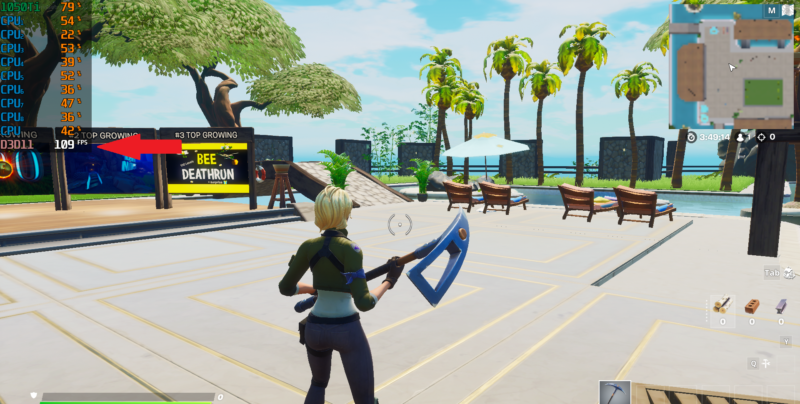
At low settings, the game, as expected, worked flawlessly.
In fact, I could have certainly benefited from a monitor with a 120Hz refresh rate as I was consistently getting between 105-120 FPS.
Medium Settings: FHD
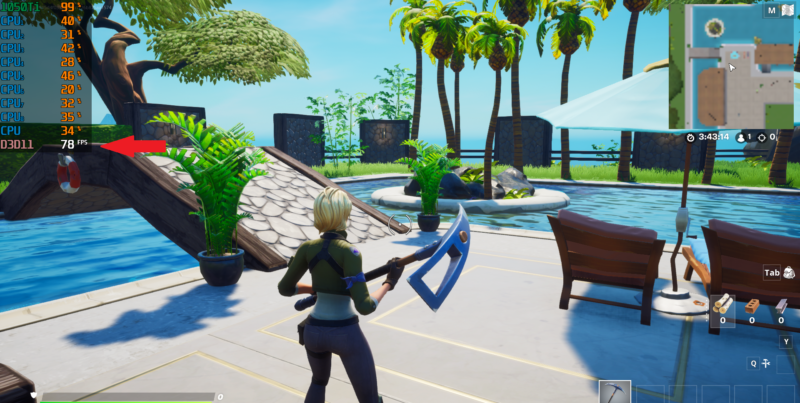
At medium graphics, the game worked just right.
I was getting about 78-80 FPS in an idle state. The game would undoubtedly drop some frames in the intense, action-packed scenario. But it would still maintain a higher than 60 FPS.
Therefore, as far as consistent 60FPS gameplay goes, this mid-range 1050Ti(mobile) with a G3D Mark score of 5919 is just perfect.
High Settings: FHD
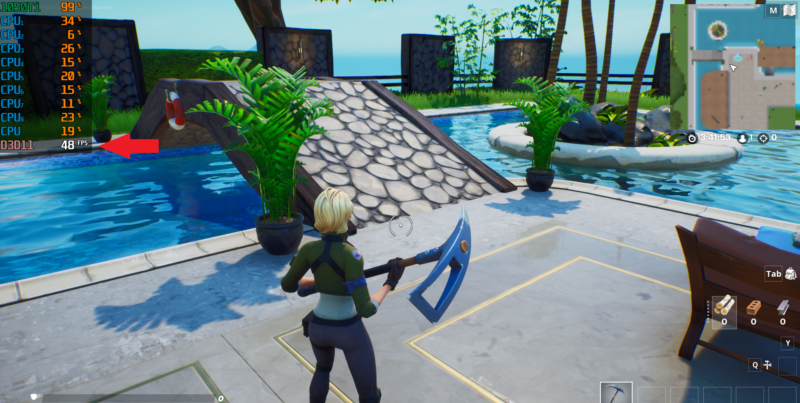
At high settings, the frame rates were hovering between 45-50 FPS, indicating the game was now pushing the limit of the graphics card.
45-50 FPS is still a very respectable frame rate because many gamers still find 30FPS a playable frame rate.
Therefore while you can still play on High Graphics on this graphic card, you won’t get the perfect 60 frame rate. With action-packed gameplay or with many structures and assets loaded up towards the end game significantly, the FPS will most certainly drop a few points here too.
Epic Settings: FHD
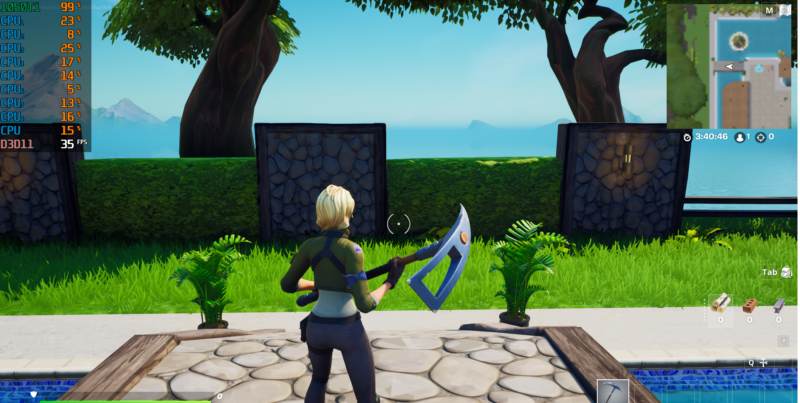
The Epic Settings was the death knell for this graphics card. At this point, the game could barely maintain a higher than 30 FPS.
For the right PC for Fortnite, the game recommends investing in an NVIDIA GTX 1080 for Epic settings. In reality, NVIDIA GTX 1080 with a G3DMark score of 15121 is an overkill for EPIC graphic settings preset at mere FHD resolution. With GTX 1080, you can play at EPIC settings AT QHD resolution.
G3D Mark Benchmark
| GPU | G3DMark | Year of Release | Remarks |
| Intel HD 4000 | 332 | 2012 | Official MINIMUM Requirements |
| Intel HD 5200 | 830 | 2013 | Official MINIMUM Requirements |
| Intel UHD 630 | 1381 | 2017 | I tested the game above on this |
| Intel UHD 750 | 1688 | 2021 | – As found 11th Gen Intel CPUs – For Budget Build |
| AMD Radeon RX 560 | 3636 | 2017 | Medium Graphics Preset |
| NVIDIA GeForce GTX 950 | 5409 | 2015 | Medium-High Settings |
| AMD R9 280 | 5605 | 2016 | Official RECOMMENDED Requirements |
| NVIDIA GeForce GTX 1050 Ti (Mobile) | 5919 | 2019 | Medium Graphics for 60 FPS or higher High Graphics for between 40-50 FPS (I Tested above on This GPU above) |
| NVIDIA GeForce GTX 960 | 6036 | 2015 | Official RECOMMENDED Requirements |
| NVIDIA GeForce GTX 1050 Ti (Desktop) | 6329 | 2016 | High Graphics |
| AMD Radeon RX 580 | 8858 | 2017 | High Settings | > 60 FPS |
| NVIDIA GeForce GTX 1060 | 9875 | 2016 | High Settings | > 60 FPS or QHD Resolution |
| AMD Radeon RX 5600 | 10879 | 2020 | High Settings | > 60 FPS and QHD Resolution |
| NVIDIA GeForce GTX 1660 Ti | 11818 | 2019 | High Settings | > 60 FPS and QHD Resolution |
| NVIDIA GeForce GTX 1070 Ti | 14308 | 2017 | High Settings | > 60 FPS and QHD Resolution |
| NVIDIA GeForce GTX 1080 | 15121 | 2016 | OFFICIAL GPU for EPIC SETTINGS @ QHD |
| AMD Radeon RX 5700 XT | 16833 | 2019 | Epic Settings | > 60 FPS or QHD Resolution |
| NVIDIA GeForce RTX 2080 | 18652 | 2019 | Epic Settings | > 60 FPS or 4K Resolution |
| AMD Radeon RX 6700XT | 18730 | 2021 | Epic Settings | > 60 FPS or 4K Resolution |
| AMD Radeon RX 6800 XT | 23420 | 2020 | Epic Settings | > 60 FPS AND 4K |
| NVIDIA GeForce 3080Ti | 26429 | 2021 | Epic Settings | > 60 FPS AND 4K |
Notes:
- Anything better than AMD Radeon RX 580 can support the EPIC settings BUT ONLY AT FHD Resolution
- G3DMark Source: videocardbenchmark.net
The chart above shows the graphics cards and their relevant resolution and FPS. The FPS and resolution information data is gathered from userbenhcmark.com and gpucheck.com.
Again a gaming PC for Fortnite can range from a basic machine that plays the game at 720P, low graphics preset all the way to a beast of a gaming rig that could play the game at Epic settings, 4k resolution while maintaining frame rates higher than 60 FPS.
It all depends upon your budget, but the flexibility of the graphics settings offered by the game allows it to be enjoyed by wide strata of PC gamers.
Does Fortnite Use Ray Tracing?
Yes, Fortnite DOES support ray tracing as well as NVIDIA DLSS.
Therefore, if you have a capable ray tracing, dedicated graphics card like the NVIDIA RTX 2000 series GPU, NVIDIA RTX 3000 GPU, or the top 6000 series AMD GPUs, you can enjoy the beautiful ray tracing elements in Fortnite.
Also Read: Do You Need a Graphics Card for Fortnite?
III. RAM Requirements for Fortnite
According to the official requirements, you need 4, 8, or 16 GB DDR4 RAM, depending upon whether you go for minimum, recommended, or Epic requirements.
How Much RAM Does Fortnite Actually Use?
In all reality, the game itself does not even come close to utilizing 4 GB RAM, let alone 16 GB DDR4 RAM.
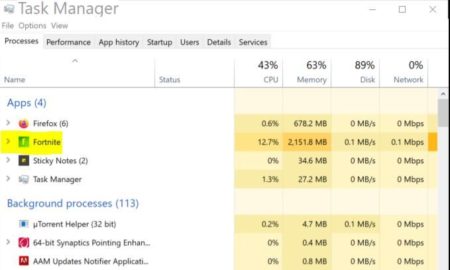
I tested the game on my system with Intel Core i7-7700HQ, 16 GB DDR4 RAM, and NVIDIA GTX 1050Ti.
According to my tests, the game utilizes about 2.15 – 2.2 GB GB DDR4 RAM.
So Why Go for 8 or 16 GB RAM When Fortnite Does not Use Even 4 GB?
Yes, the game does not utilize a lot of RAM; however, every system has background applications running which can eat up your RAM, so you have to consider that too. The more robust apps you have running in the background, the more RAM will be reserved.
Take my PC above, for instance. You can see in the task manager above that 63% of my total 16 GB memory was utilized when I captured this screenshot.
63% of 16GB equals 10.08 GB. If I subtract the 2.2 GB RAM used by the game, that would equate to about 8 GB of RAM used by the background apps and system services!
Hence, to run the game smoothly with my current PC configuration and apps installed, I would need at least 11 GB of RAM (give or take a GB).
Now if I had a streaming application running in the background as well, that would have skyrocketed the RAM usage resulting in me requiring perhaps more than 16 GB of RAM.
As such, a good PC for Fortnite may quickly require 8 GB DDR4 RAM. But the right PC Build for Fortnite, one that is capable of professional streaming, could easily warrant 16 GB or more RAM.
You Can Reduce Your Memory Usage
Of course, the 8 GB of RAM used by my system above is certainly not ideal. I could save a lot by closing off some background apps. However, I have the luxury of keeping them open since I have enough RAM.
If I had only 8 GB of RAM, I would have certainly been compelled to close a lot of the background applications off for the smooth running of the game and the PC.
Stick to Basic RAM Specs
I recommend that you stick with basic DDR4 RAM specs meaning a nominal 3000-3200MHz frequency and CAS Latency of 16 or 18.
Corsair Vengeance LPX DDR4 RAM kits are the obvious choice for most gamers. They look good, are popular, have great value, and are reliable.
However, choosing a lower frequency or a higher CAS latency stick can also find cheaper RAM sticks.
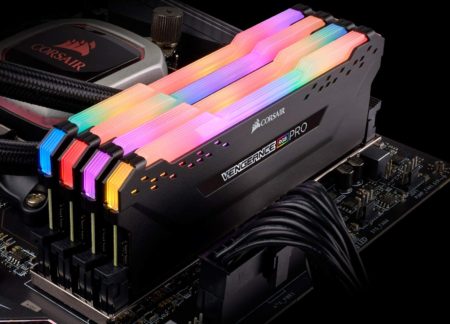
If you are an enthusiast with a good budget to spare for your PC for Fortnite, you could even find DDR4 RAM sticks with RGB lights, such as the Corsair Vengeance RGB Pro, at a slightly higher price tag than normal.
Also Read: How to Tell if RAM Will Work with Your Motherboard?
IV. Hard Drive Requirements for Fortnite
There isn’t any specific requirement for a storage drive for Fortnite. When writing this article, the game occupied about 30 GB of hard disk space, but this number will certainly grow as the game releases newer content and updates.
Regarding my hard drive recommendations, I would suggest getting an NVMe SSD in a heartbeat.
Let us look at some basic information regarding the hard drive so you can better gauge the better option for yourself.
There are essentially three types of hard drives that you can get for your Fortnite PC:
1. Hard Disk Drive
Your average spinning hard disk drives connect to the SATA ports.
These are large and slow but very cheap. A good 2TB Seagate BarraCuda 7200 RPM hard disk drive can cost you about $55. Thus if you have a limited budget but want to maximize your storage capacity, then hard disk drives are still the way to go.
At best, hard disk drives have a transfer rate of about 200 MB/s. This is a lot slower than even the slowest SSD out there.
While Fortnite itself won’t benefit much from a faster hard drive once it’s loaded and running, the rest of your experience on your PC will.
Also Read: How many SATA ports do I have?
2. SATA SSDs
SATA SSDs also connect to the SATA ports on your motherboard. These have a transfer speed of 550 MB/s but are quite expensive.
A 500 GB SATA SSD can cost you $60.
Their only advantage is that they can interface with a SATA port, which can be found in abundance on any motherboard.
But other than that, I would not recommend these. Instead, I recommend the NVMe SSDs, which cost the same as SATA SSD but are multiple times faster:
3. NVMe SSD

Image: Seagate 3TB BarraCuda SATA vs. Samsung SSD 850 EVO vs. Samsung 970 EVO NVMe Source/Credit: Jollibeee86 Reddit
The NVMe SSDs use the PCIe interface. They plug into the dedicated M.2 slot found on almost all newer motherboards.
The awesome part about NVMe SSDs is, of course, the performance. A Gen 3 NVMe SSD utilizes the PCIe 3.0 interface and can reach read speeds of a whopping 3500 MB/s.
A Gen 4 NVMe SSD utilizes the PCIe 4.0 interface and can theoretically reach read speeds of 7000 MB/s (5000 MB/s typically).
They cost almost the same as a SATA SSD.
Compared to the normal HDD, NVMe SSD is still four times as expensive if you have to take the per GB cost, but the performance gains are at least 15 times as much.
| Storage Type | Read Speeds |
| Hard Disk Drive | 200 MB/s |
| SATA SSD | 550 MB/s |
| Gen 3 NVMe SSD | 3500 MB/s |
| Gen 4 NVMe SSD | 7000 MB/s |
- Gen 3 NVMe SSD uses the PCIe 3.0 interface, while Gen 4 NVMe uses the PCIe 4.0 interface.
Also Read: How many PCIe Lanes Does M.2 Slot Use?
So Should You Go for an SSD for Your Fortnite PC Build?
I would recommend that you do so if you value a smooth-running PC. Unless you are on a very tight leash with your budget, there is absolutely no reason why you should not consider investing in an NVMe SSD.
Many also opt for a combination of an NVMe SSD and HDD. Here the NVMe SSDs serve as the primary driver for the OS and for installing the games, whereas the HDD serves as an archival drive for saving up media and large files.
Again, it should be reiterated here that regarding the performance scores and FPS of Fortnite, the choice of your hard drive will have no impact once the game is loaded up.
This is because once the game is up and running, it utilizes the RAM for storing temporary data, NOT the HDD. This is the way all apps and games are designed.
V. Motherboard for Fortnite
As is the case with all gaming PC builds, for a PC for Fortnite, the motherboard should ideally cost about half as much as the CPU.
So if you go for a CPU worth $150, it would be wise to go for a motherboard that costs half as much.
While this isn’t a rule of thumb, it is a great guideline. This is because there should be a parity between the CPU and the motherboard specs.
It would be unwise to spend much on a CPU yet cheap out on a motherboard.
So, for instance, if you choose to go for an AMD Ryzen 7 5800X, yet the motherboard of your choice is an AMD A520, you will have a serious disparity between the two.
While the CPU will undoubtedly work, as the AMD A520 offers the compatible AM4 socket, it just does not have the right VRM size, phase power design, or even the heat sinks to deliver power to a beast of a CPU stably.
This brings us to motherboard Chipsets:
Motherboard Chipset to Choose for Fortnite
Depending upon your build, the motherboard chipset you choose will vary.
The chipset is a very important consideration as it determines many of the specs, directly and indirectly reflecting your overall budget.
Among other things, the chipset determines the following:
- The socket for the CPU
- How many PCIe lanes does it have
- PCIe version
- The VRM size and phase power design
- Whether it is overclockable or not
- SLI/Crossfire support
- Amount of ports and slots and their version
There are three series of chipsets by both Intel and AMD for consumer-grade motherboards.
AMD Motherboard Chipsets
AMD has the following motherboard chipset series:
- A series, such as the A320 and the A520, for budget, builds
- B series, such as the B450 and B550, for mid-range builds
- X series, such as the X470 and the X570, for enthusiasts and high-end build
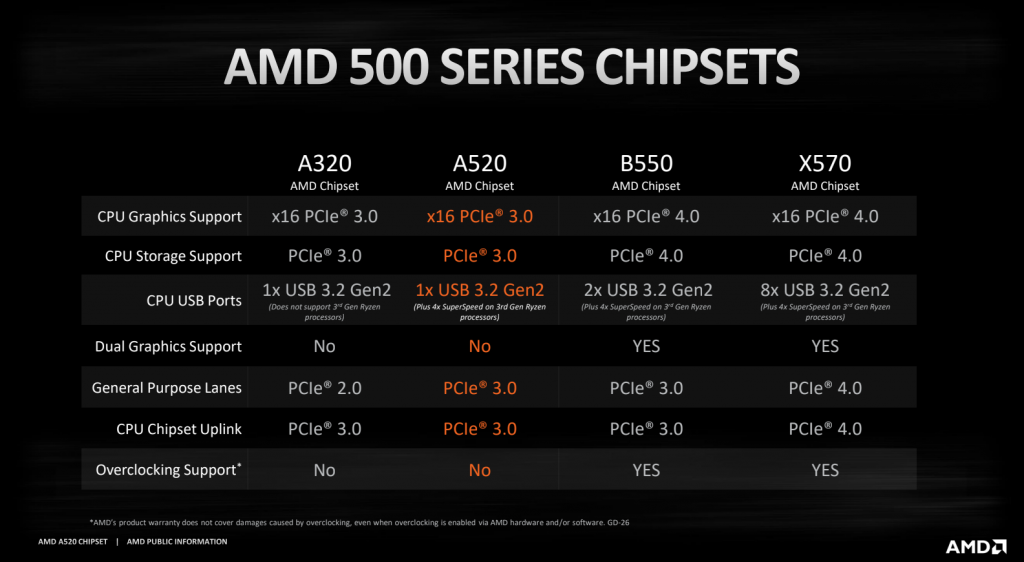
The table above summarizes the basic differences between the AMD chipsets.
If you want to build a budget PC for Fortnite, I recommend the A320 or the A520 chipset. Motherboards with the A320 chipset are perhaps the cheapest for the AM4 socket.
The problem with A series chipsets is that they do not feature overclocking and have weak VRMs (voltage regulator modules). Hence, they are not ideal for powerful CPUs.
There is also an issue with the PCIe version. The newer B series and X series motherboards offer PCIe v4.0, which the A series does not.
For mid-range PC build for Fortnite, the B series chipset is recommended as it supports overclocking. But if you want to build a powerful gaming rig with an AMD Ryzen 7 or Ryzen 9 CPU, then the X570 is recommended.
Intel Motherboard Chipsets
Intel also has three popular series of consumer-grade boards:
- B series, such as the B460 and the B560, are intended for budget builds.
- H series, such as the H510, is intended for mid-range builds
- Z series, such as the Z490 and Z590, is for high-end builds
Unlike AMD, where both the midrange B series and the high-end X series support overclocking, with Intel, only the Z series supports overclocking, which is quite unfortunate.
There is also the difference in PCIe lanes, VRM design, version of the USB and PCIe interface, etc., between the chipsets.
You can learn more about the difference here.
More Gaming Build Guides
- PC for Rocket League
- PC for Roblox
- PC for Minecraft
- PC for League of Legends
- PC Without Graphics Card
- PC for World of Warcraft
More Work Build Guide
Frequently Asked Questions
1. Is it necessary to have a solid-state drive (SSD) for playing Fortnite on PC?
While it is not necessary to have a solid-state drive (SSD) for playing Fortnite on PC, it can significantly improve the game’s loading times and overall performance.
If you can afford it, it is recommended to use an SSD instead of a traditional hard disk drive (HDD) for the operating system and game files.
2. Can I use a pre-built PC for playing Fortnite or do I have to build one from scratch?
You can use a pre-built PC for playing Fortnite, but you should check its system requirements first.
Make sure that the PC has a dedicated graphics card, sufficient RAM, and a processor that meets or exceeds the game’s recommended requirements.
If the pre-built PC doesn’t meet these requirements, you may need to upgrade some of its components.
3. What other peripherals do I need for playing Fortnite on PC, such as a gaming keyboard or mouse?
In addition to a monitor, keyboard, and mouse, you may also need a headset or speakers for playing Fortnite on PC. A gaming headset with a built-in microphone can be useful for communicating with other players during the game.
4. Are there any specific settings or configurations I should optimize for playing Fortnite on PC?
To optimize your Fortnite experience on PC, you should adjust the in-game settings based on your hardware specifications.
For example, you can lower the graphics quality settings if your PC has a weaker graphics card or increase the resolution if you have a high-end monitor.
Additionally, you should make sure that your PC’s drivers are up to date, and unnecessary background programs are closed while playing the game.
